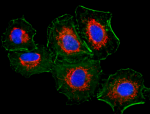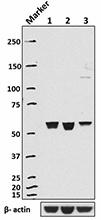- Clone
- P83G8 (See other available formats)
- Regulatory Status
- RUO
- Other Names
- HSPD1, HLD4, CPN60, GROEL, HSP65, SPG13, HuCHA60, Mitochondrial Matrix Protein P1, P60 Lymphocyte Protein
- Isotype
- Mouse IgG1, κ
- Ave. Rating
- Submit a Review
- Product Citations
- 1 publications

HSP60, a mitochondrial chaperonin, is essential for the refolding, assembly, and transportation from the cytoplasm to mitochondrial matrix. It shares a high degree of homology and function similarity to bacteria GroEL. Studies also show that HSP60 may participate in some autoimmune diseases along with autosomal dominant and autosomal recessive neurodegenerative disorders.
Product DetailsProduct Details
- Verified Reactivity
- Human, Mouse, Rat
- Antibody Type
- Monoclonal
- Host Species
- Mouse
- Immunogen
- Purified recombinant fragment (265-462 a.a.) of human HSP60 expressed in E. coli.
- Formulation
- Phosphate-buffered solution, pH 7.2, containing 0.09% sodium azide.
- Preparation
- The antibody was purified by affinity chromatography.
- Concentration
- 0.5 mg/ml
- Storage & Handling
- The antibody solution should be stored undiluted between 2°C and 8°C.
- Application
-
WB - Quality tested
ICC - Verified - Recommended Usage
-
Each lot of this antibody is quality control tested by Western blotting. For Western blotting, the suggested use of this reagent is 0.5 - 2.5 µg per ml. For immunocytochemistry, a concentration range of 1.0 - 10 μg/ml is recommended. It is recommended that the reagent be titrated for optimal performance for each application.
- Product Citations
-
- RRID
-
AB_2566474 (BioLegend Cat. No. 681502)
Antigen Details
- Structure
- HSP60 contains 573 amino acids with a predicted molecular weight of 61 kD.
- Distribution
-
Mitochondrial matrix.
- Function
- HSP60 plays important roles in trafficking, folding, and the assembly of mitochondrial proteins. Under stress conditions, it may prevent protein misfolding and aggregation.
- Interaction
- Interacts with HRAS (by similarity), HBV protein X, HTLV-1 protein p40tax, ATAD3A, METTL20, and METTL21B.
- Ligand/Receptor
- TLR4.
- Biology Area
- Cell Biology, Immunology, Innate Immunity, Mitochondrial Function, Neuroinflammation, Neuroscience, Neuroscience Cell Markers
- Molecular Family
- Mitochondrial Markers
- Antigen References
-
1. Bukau B, Horwich AL. 1998. Cell 92:351.
2. Hansen JJ, et al. 2002. Am. J. Hum. Genet. 70:1328.
3. Kol A, et al. 2000. J. Immunol. 164:13.
4. Jindal S, et al. 1989. Mol. Cell Biol. 9:2279.
5. Magen D, et al. 2008. Am. J. Hum. Genet. 83:30.
6. Chandra D, et al. 2007. J. Biol. Chem. 282:31289. - Gene ID
- 3329 View all products for this Gene ID
- UniProt
- View information about HSP60 on UniProt.org
Related FAQs
Other Formats
View All HSP60 Reagents Request Custom Conjugation| Description | Clone | Applications |
|---|---|---|
| Purified anti-HSP60 | P83G8 | WB,ICC |
| Direct-Blot™ HRP anti-HSP60 | P83G8 | WB |
Compare Data Across All Formats
This data display is provided for general comparisons between formats.
Your actual data may vary due to variations in samples, target cells, instruments and their settings, staining conditions, and other factors.
If you need assistance with selecting the best format contact our expert technical support team.
-
Purified anti-HSP60
Total cell lysate from HeLa cells (lane 1, 15 µg), NIH3T3 ce... 
A549 cells were fixed with 4% paraformaldehyde (PFA) for ten... -
Direct-Blot™ HRP anti-HSP60
Total cell lysate from HeLa cells (lane 1, 15 µg), NIH3T3 ce...

















Follow Us